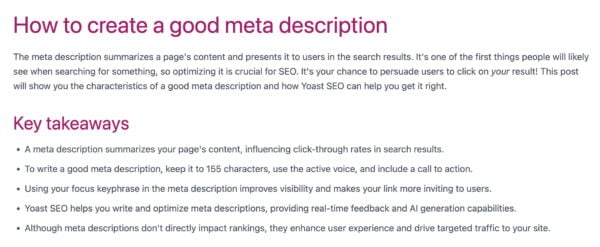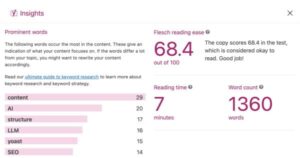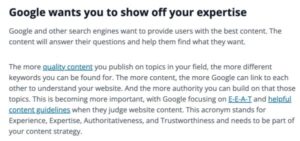We know that most readers skim. We also know that search engines prefer clear and easy-to-understand content. Luckily, a good summary can help with both. A summary gives your reader the core ideas quickly, while also helping your chances of ranking your content. Learning how to write a summary helps you give your content the love it needs.
Key takeaways
- A summary provides a concise overview of your content, helping readers and boosting SEO.
- Effective summaries improve readability and help readers quickly determine content value.
- To write a strong summary, identify key points, use clear language, and integrate keywords naturally.
- Summaries differ from titles, introductions, and conclusions as they target readers already engaged with the content.
- AI can assist in generating summaries, but always review and refine to ensure clarity and accuracy.
What is a summary?
If we are looking for the definition, we can say a summary is a short and focused overview of your content’s main points. A good summary answers three questions:
- What is this text about?
- Why should I care about it?
- What will I learn from reading it?
Keep in mind, a summary is not a sales pitch or something in-depth. You need to strip it down and offer just the essentials for readers to understand in seconds.
Expert insights

Agnieszka Szuba: Yoast developer and researcher on summaries
“Summaries can provide a lot of value to both human readers and bots. And with the help of AI features like Yoast AI Summarize, they can be created very easily. So adding a summary can be a quick way to boost the readability and engagement of your content.”
Why are summaries important?
Now that we know what summaries are, let’s answer the question of why they are so important. There are many answers to that question, but we’ll answer that here.
Improves readability
One of the main aspects of a good text is its readability, but it’s hard to judge a book by its cover. Before readers decide to invest their precious time in reading your content, they need to know if it is worth it. A well-written summary helps them understand the value of your content in seconds. They’ll also get an idea of how your writing is.
Helps readers decide fast
As we mentioned, the time aspect is very important today. Everyone is busy, and people need to know whether your content is worth their time. So busy visitors want to know: “Is this worth my time?” A clear summary can help speed up that decision process.
Enhances SEO
Not only readers but also search engines are looking to understand your content. Search engines see if content matches user intent, and a good summary can help them figure that out.
A well-written summary mentions your target keywords naturally. Good ones increase the chance of your content appearing in highlighted search results like featured snippets. In addition, summaries may help reduce bounce rate because they can manage and set expectations for readers.
How to write an effective summary
Now that you know why summaries can be so helpful, let’s find out how to write effective ones.
Identify the main points
The most important thing is to identify the main points of the content that need to feature in the summary. To help you do this, ask yourself the following questions:
- What’s the primary message of the content?
- What are the two or three key takeaways?
- What does the reader need to know?
Remember, keep it clean and simple. Avoid using examples, anecdotes, or secondary details that muddy the point you are trying to make.
Be concise and clear
Your summary needs to be as easy to understand as possible. Try to aim for three to five sentences (or 50 to 100 words). Cut filler words. Here’s an example:
Wrong: “In this article, we’re going to be talking about some of the most important aspects of writing summaries, which can really make a big difference.”
Right: “This guide covers three key rules for writing summaries: clarity, brevity, and keyword placement.”
Use simple, direct language
We’ve always been big fans of writing as clearly and simply as possible. One of those things to consider is jargon. Whenever you can, try to avoid using jargon. Write like you’re explaining it to a colleague over coffee.
Integrate keywords naturally
Your summary should include the main keywords of your article. For a summary of the article you’re reading now, the focus keyphrase would be “how to write a summary”. Also, try to fit in one or two related terms, but don’t force them. Always prioritize readability.
Match your content’s tone
The next thing to think about is making sure that the summary’s tone matches the content’s tone. For instance, a summary for a technical guide should be precise, while one for a lifestyle blog can be more conversational. Keep it consistent.
Dos and don’ts of writing summaries
For this article, we’ve created a helpful table that quickly outlines the main rules of writing summaries. Remember these!
| Do | Don’t |
|---|---|
| Focus on key takeaways only | Add extra details or tangents |
| Keep it short and scannable | Write dense paragraphs |
| Use keywords naturally | Stuff keywords awkwardly |
| Match the tone of your content | Switch to a different style |
| Test if it stands alone | Assume readers know the context |
Examples of weak vs. strong summaries
We’ve shown you the theory of good and bad summaries, but now let’s review a couple of examples to see it in practice.
A blog post (how-to guide)
Topic: “How to Start a Podcast in 2025”
Weak: “Starting a podcast can be hard, but this post gives you some tips on equipment, topics, and editing to help you get going.”
Strong: “Launch your podcast in 5 steps: Choose a niche, pick budget-friendly gear (under $200), record like a pro, edit with free tools, and grow your audience. Avoid rookie mistakes with our checklist.”
Why it works:
- Numbers (“5 steps”) set clear expectations
- Specifics (“budget-friendly gear,” “free tools”) add value
- Actionable (“avoid rookie mistakes”) hints at practical advice
A product page (e-commerce)
Product: “Ergonomic Office Chair – Model X200”
Weak: “The Model X200 is a great chair for people who sit a lot. It has features that make it comfortable and good for your back.”
Strong: “Reduce back pain with the Model X200: Adjustable lumbar support, breathable mesh, and 360° armrests. Rated #1 for home offices under $300. Free shipping + 30-day trial.”
Why it works:
- Highlights benefits (not just features)
- Includes social proof (“Rated #1”)
- Adds urgency (“30-day trial”)
A research report (B2B)
Topic: “2025 Digital Marketing Trends: AI and Automation”
Weak: “This report looks at how AI is changing marketing. It covers trends and stats that businesses should know about.”
Strong: “78% of marketers now use AI for content creation (up from 42% in 2023). This report breaks down:
- Top AI tools for ROI in 2025
- How automation cuts campaign costs by 30%
- Case studies from brands like Nike and HubSpot.”
Why it works:
- Leads with a stat to grab attention
- Bullet points improve scannability
- Names brands for credibility
News article
Topic: “New Study Links Screen Time to Sleep Disorders in Teens”
Weak: “A new study shows that teens who use screens before bed might have trouble sleeping. Researchers say this is a growing problem.”
Strong: “Teens with 3+ hours of nightly screen time are 5x more likely to develop insomnia, per a Harvard Medical School study. Key findings:
- Blue light delays melatonin by 90 minutes.
- Social media (not gaming) is the worst offender.
- Solutions: ‘Screen curfews’ and orange-light filters.”
Why it works:
- Quantifies risk (“5x more likely”)
- Debunks myths (“social media vs. gaming”)
- Offers solutions (not just problems)
Case study
Topic: “How Company Z Increased Sales by 200% with Email Marketing”
Weak: “Company Z used email marketing to grow their sales. This case study explains what they did and the results they got.”
Strong: “Company Z turned $5K/month into $15K/month in 6 months using:
- Segmented lists (3x higher open rates)
- Abandoned-cart emails (recovered 12% of lost sales)
- A/B-tested subject lines (‘Your cart misses you’ won)
Steps and templates included.”
Why it works:
- Leads with results (“$5K to $15K”).
- Uses numbers to prove impact.
- Teases actionable content (“templates included”).
What did we learn from these examples?
- Start with the most valuable info (stats, results, or a bold claim).
- Use numbers (steps, percentages, time) to add credibility.
- Match the format to the content type (bullets for reports, emojis for social media).
- Avoid vague language (“some tips” → “3 proven strategies”).
Here’s a pro tip for you: Test your summary by asking yourself if it would make you click/read more. Does it work even if you skip the full content?
Summaries vs. intros, conclusions, titles, and meta descriptions
There are other options to help readers and search engines quickly understand your content. What’s the difference between these? Titles and meta descriptions are for getting people to click from the SERP, while summaries are for readers already on your content.
| Element | Purpose | Length | Audience | Example |
|---|---|---|---|---|
| Title | Grabs attention; tells readers (and search engines) what the content is about. | 50-60 chars (SEO ideal) | Searchers + readers | “How to Write a Summary in 5 Steps (With Examples)” |
| Introduction | Hooks the reader; sets up the topic and why it matters. | 1-3 paragraphs | Readers (and search engines) | “Struggling to keep readers engaged? A strong summary can double your content’s impact—here’s how to write one.” |
| Summary | Condenses main points for quick understanding. | 3-5 sentences | Readers who skim | “Learn the 5 rules for summaries: cut fluff, lead with key points, use keywords, and match your content’s tone.” |
| Conclusion | Wraps up; often includes a CTA or final thought. | 1 paragraph | Readers who finish the piece | “Now that you know how to summarize effectively, try rewriting an old post’s summary and track the difference in engagement.” |
| Meta desc. | Encourages clicks from search results. | ~150-160 chars | Search engines + potential visitors | “Master the art of writing summaries with this step-by-step guide. Improve readability, SEO, and reader retention in minutes.” |
Benefits and pitfalls of using AI for summaries
One of the best ways of using AI in your work is to use it to summarize content. It’s almost what it was designed to do. AI tools like Yoast AI Summarize can draft summaries in seconds. Of course, you need to keep an eye on the outcome and adjust where needed.
Benefits
There are many benefits to using AI to generate summaries.
- The AI is fast: AI can generate a summary almost instantly
- It’s consistent: The AI works very consistently based on your rules
- It’s an additional content check: If it stumbles, your content’s points are not clear
Pitfalls
Using AI has a lot of benefits, but also risks.
- Results might lack nuance or miss a certain emphasis or humor
- It can also come out sounding very robotic or boring
- It might focus on the wrong things, so it could highlight minor points instead of critical ones
Best practices for using AI to generate summaries
Always use AI as a starting point, then compare the AI summary to your key messages. If it needs adjusting, edit the summary for accuracy, tone, and flow. Then test it to learn if it makes sense alone.
In the real world, this would mean installing an AI plugin on your WordPress site or using Yoast SEO’s AI Summarize feature. Open an article on your site and add the Yoast AI Summary block. Have it generate a summary based on your article. Check the outcome and refine it to sound human and align with your goals.

Conclusion
A strong summary aims to please two different consumers: first, the readers who want quick answers and search engines that reward clarity and readability. Writing a good summary is all about keeping it short, direct, and keyword aware. Avoid fluff and focus on the key takeaways.
Today, it’s fine to use AI to help you with summaries, but always check them. If you are not happy, edit them.
Here’s a nice exercise: Find an old post, write a new summary based on these learnings, and see if engagement picks up. Often, it’s the small tweaks that have the biggest impact.
The post How to write an effective summary for your content appeared first on Yoast.





